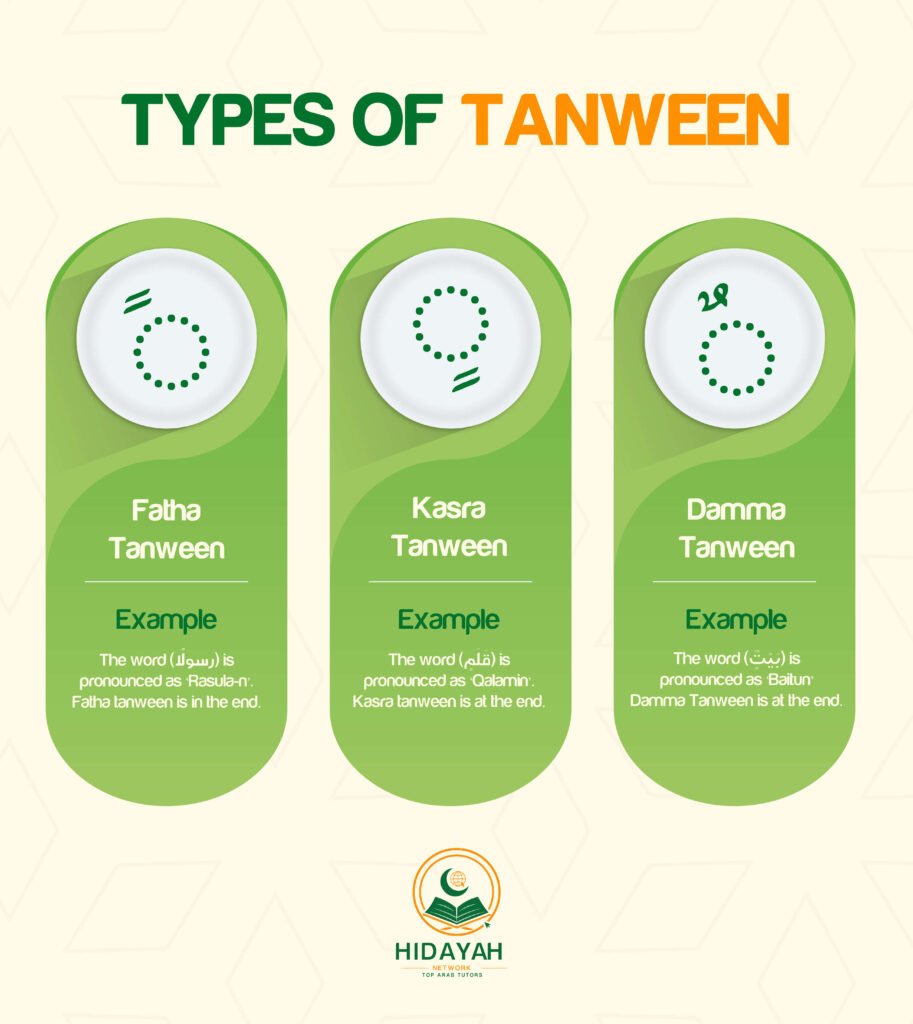Mastering Tajweed can be exciting and fulfilling. The beauty it brings to your recitation is manifold. It is essential to apply the Tajweed rules while reciting and memorizing Quran to avoid errors and to beautify your tones. There are two important elements in Tajweed: Noon Saakin and Tanween. These are like secret codes that help us pronounce Quranic words correctly. Think of them as special tools for unlocking the beauty of the Quran.
Once you learn Noon Saakin and Tanween, we can improve our recitation skills and deepen our connection with the holy text. Today, we will show you simple examples to illustrate how these elements work. Additionally, we will learn their types, rules, and a lot more, all here! Let’s get started!
Table of Contents
ToggleWhat is Noon Saakin?
Noon Saakin, an integral concept in Arabic and Tajweed, denotes the letter “ن” (noon) when it appears without any accompanying vowel sounds, indicated by a small circle called sukoon or jazm. Its significance lies in its role in Quranic recitation accuracy. When encountered, it dictates specific pronunciation rules, especially concerning the sounds following it.
Example 1: In Surah An-Naas (114:4), the word “مِنْ” (min)
The letter “ن” comes at the end with sukoon, indicating its silent nature. When reciting we will not elongate it and not put any movement on it.
Example 2: The word اَنْعَمتُ (An-amtu)
Here, “ن” sits in the middle with a silent sound, marked with sukoon.. When reciting, clearly pronounce the Noon saakin without elongating and adding movements to it.
Mastering Noon Sakinah is vital to learn the Quran Tajweed online. So, practice this rule as much as you can.

Get 40% OFF Now!
What is Tanween?
Tanween is a fundamental aspect of Arabic grammar, serving as a marker for indefinite nouns and adjectives. In linguistic terms, it represents the absence of specificity, similar to the English articles “a” or “an.” This diacritical mark consists of two small lines placed above a letter, indicating the sound of an “n” followed by a short vowel.
There are three primary types of Tanween:
- Fatha
- Kasra
- Damma

Tanween examples
Fatha Tanween
Fatha denotes the haraka of the letter preceding Tanween; namely the last letter in the word. It is denoted with 2 short lines on the top of the letter and is sounded as “an”.
Example: The word (رَسُولًا) is pronounced as ‘Rasula-n’. Fatha tanween is in the end.
Kasra Tanween
Kasra Tanween, denoted by two small “n” shapes below the letter, signifies a short “in” sound.
Example: The word( قَلَمٍ) is pronounced as ‘Qalamin’. Kasra tanween is at the end.
Damma Tanween
Damma Tanween, shown by two small stacked “u” shapes, represents a short “un” sound.
Example: The word is pronounced as ‘Baitun’ Qasra Tanween is at the end.
Each type modifies the pronunciation of the last letter of a word and indicates the corresponding vowel sound.
Difference Between Noon Saakin and Tanween?
Noon Sakin refers to the letter noon (ن) with a sukoon, either at the end or within a word, while Tanween is represented by double fatha (ًً), double kasra (ٍٍ), or double damma (ُُ) at the end of a word. Both are one of the most important types of Tajweed rules.
Here’s an extensive table highlighting the differences between Noon Sakin and Tanween:
| Aspect | Noon Sakinah | Tanween |
|---|---|---|
| Definition | Letter noon (ن) with a sukoon (absence of vowel sound) | Double vowel marks (fatha/kasra/damma) indicating “n” sound |
| Occurrence | Nouns, verbs, and huroof (letters) | Only in nouns |
| Place in the word | Middle or end of a word | Only at the end of a word |
| Written form | Noon letter with sukoon or without any vowel marks | Two vowel marks (fatha/kasra/damma) at the end of a word |
| Pronunciation | Nasalized “n” sound | Nasalized “n” sound |
| Tajweed rules | Subject to Tajweed rules (Izhar, Idghaam, Iqlaab, Ikhfaa) | Subject to Tajweed rules (Izhar, Idghaam, Iqlaab, Ikhfaa) |
Noon Sakin And Tanween Rules

1. Idhar
When reciting the Quran, achieving accurate pronunciation is essential for preserving the beauty and meaning of the text. Here’s where understanding Izhar, especially with Noon Saakin and Tanween, becomes crucial.
Making the “n” Heard Clearly
Izhar, meaning “to manifest” in Arabic, refers to the distinct pronunciation of the “N” sound in Noon Saakin (a stationary noon with a small circle above) and Tanween (ending diacritic marks indicating indefinite nouns) in specific situations. This ensures the “N” isn’t swallowed or merged with the following letter.
The Huroof Halaqiyya
Izhar comes into play when a Noon Saakin or Tanween is followed by one of the six Huroof Halaqiyya. These “throat letters” are pronounced from the throat and include Hamza (ء), Haa (ه), Ayn (ع), Haa (ح), Ghayn (غ), and Khaa (خ).
Here’s the magic of Izhar:
- When encountering a Noon Saakin or Tanween, pronounce the “N” sound clearly and distinctly, separating it from the following letter. Think of it as a small pause between the “N” and the upcoming sound.
- Avoid prolonging the “N” sound or creating a nasal drone (Ghunna) that merges with the next letter. The “N” should be crisp and detached.
Examples of Idhaar from the Quran
Let’s see Izhar in action with some Quranic verses:
- مِن حَكِيمٍ (min hakeem): Here, the Noon Saakin at the end of “حَكِيمٍ” is followed by Haa. Izhar dictates a clear separation between the “N” and the Haa sound.
- وَمَا يَأْتِيهِم مِّن نَّبِيٍّ (wa maa ya’tihim min nabiyy): The Tanween on “نَّبِيٍّ” is followed by Ya. With Izhar, the “N” should be pronounced distinctly before transitioning to the Ya sound.
By mastering Izhar, you achieve several benefits:
- You ensure the Quran is recited as intended, preserving its meaning and beauty.
- Clear pronunciation of the “N” adds depth and richness to your recitation.
- The distinct “N” enhances the overall listening experience for yourself and others.
2. Iqlab
Iqlab, meaning “conversion” in Arabic, refers to a specific transformation that occurs when a Noon Saakin or Tanween encounters the letter Baa (ب). The original “N” sound of the Noon Saakin or Tanween is not entirely replaced. Instead, it’s subtly converted into a Meem (م) sound. This conversion isn’t a simple switch.
It’s accompanied by Ghunnah, a nasal resonance that extends the sound for a beat or two. Imagine a gentle hum accompanying the “M.” The key player in this transformation is the letter Baa. When Baa follows a Noon Saakin or Tanween, Iqlab kicks in, creating the unique “M” sound with Ghunnah.
So, how do you know when Iqlab is happening? Here’s your detective kit:
- Look for the letter Baa following a Noon Saakin or Tanween. If Baa is there, Iqlab is a strong suspect.
- Pay attention to the pronunciation. Does the “N” sound subtly transform into a resonant “M” with a hint of a nasal hum? If so, Iqlab is at play.
Examples of Iqlab
“لَنَسْفَعًا بِالنَّاصِيَةِ” tanween in the end of the verb (لَنَسْفَعًا ) is followed by letter Baa in the next word. We will do Iqlab here and change the sound of noon tanveen into meem.
Iqlab isn’t just about technicalities. It has a profound impact on the recitation:
- The subtle conversion and the accompanying Ghunnah add a layer of richness and beauty to the recitation, making it more melodious and captivating.
- By ensuring the transformation and Ghunnah, Iqlab prevents the “N” sound from merging with the Baa, maintaining the distinct pronunciation intended for the Quran.
3. Idghaam
Idgham literally means to mix together or to put something into the other. There are six letters of Idghaam in the Arabic Alphabet. These letters are: Yaa (ي), Raa (ر), Meem (م), Laam (ل), Waw (و), and Noon (ن). These letters are Mutaharrik (has haraka), and when following the Noon Sakinah/Tanween, Idghaam occurs.
In Tajweed, it means mixing up the pronunciation of Noon Sakinah/Tanween with one of the Idhaam letters (Mutaharik letter/has Harakah) so that they become one single Mushaddad letter (With Shaddah), where this Mushaddad letter is of the Mutaharrik letter’s sound.
Idgham may and may not be accompanied by Ghunnah of two beats (sound originating from the nose) depending on the Idghaam letter).
Idghaam with Ghunna
Idgham with ghunna applies if Noon Sakinah/Tanween precedes any of these four letters: Yaa (ي), Noon (ن), Meem (م), and Waw (و). Ghunna is a sound coming out of the nose while pronouncing the Idghaam. Ghunna amount is two beats (The time taken to fold and unfold your finger slowly).
Idghaam without Ghunna
This applies to the remaining two letters of Idghaam which are Raa (ر) and Laam (ل).
4. Ikhfaa
Ikhfaa literally means to conceal something or prevent it from appearing. In Tajweed. Ikhfaa means to hide the Noon Sakinah/Tanween from clear pronunciation when preceded by Ikhfaa letters. Ikhfaa is actually an intermediate phase between Izhaar and Idghaam, where Noon Sakinah/Tanween is not clearly pronounced nor totally mixed up into the following letter.
Ikhfaa comes into play when a Noon Saakin or Tanween is followed by any of these 15 letters (excluding those used in Idhar, Idghaam, and Iqlab):
The 15 Letters of Ikhfaa:
- ج (Jeem)
- ذ (Dhaal)
- د (Daal)
- ث (Thaa)
- ت (Ta)
- ض (Dhad)
- ص (Saad)
- ش (Sheen)
- س (Seen)
- ز (Zain)
- ك (Kaaf)
- ق (Qaf)
- ف (Fa)
- ظ (Dhaad)
- ط (Taa)
So, how do you actually pronounce Noon Saakin or Tanween with Ikhfaa Shafawi? Here’s the key:
- You don’t completely eliminate the “N” sound. Instead, you pronounce it subtly, almost like a whisper. Imagine the faint echo of an “N” before the next sound.
- A crucial element of Ikhfaa is Ghunna, the nasal resonance that extends for about two vowel sounds (harakatayn). This adds a unique depth and character to the pronunciation.
- After the subtle “N” and Ghunna, the following letter from the list of 15 is pronounced clearly and distinctly. The focus shifts from the “N” to the upcoming sound.
Quranic Examples of Ikhfaa
Let’s see Ikhfaa at work in the Quran:
- بِسْمِ اللهِ الرَّحْمٰنِ الرَّحِيْمِ (bismi Allahi ar-Rahmani ar-Rahim): Here, the Tanween at the end of “bismi” is followed by the Raa (ر) in “Allahi.” Ikhfaa applies, creating a subtle “N” sound with Ghunna before the clear pronunciation of Raa.
- الْحَمْدُ لِلَّهِ رَبِّ الْعَالَمِينَ (al-hamdu lillahi Rabbil-‘Alameen): In this verse, the Tanween at the end of “al-hamdu” is followed by the Laam (ل) in “lillahi.” Ikhfaa is used, resulting in a faint “N” with Ghunna before the clear Laam sound.
Conclusion
Mastering Noon Saakin and Tanween in Tajweed is vital for accurate Quran recitation. Understanding their definitions, occurrences, and pronunciation differences is key. Tajweed rules like Izhar, Iqlaab, Idghaam, and Ikhfaa further enhance recitation skills. Examples demonstrate these concepts in practice, aiding comprehension.
With dedication and practice, learners can refine their recitation, deepening their connection with the Quran. Enriching the experience, mastering Tajweed ensures reverence and precision in conveying the sacred text’s message.
Frequently Asked Questions
What are the 4 Rules of Noon Saakin and Tanween?
These rules govern how to pronounce the “N” sound in Noon Saakin (stationary noon with a small circle) and Tanween (ending diacritic marks) in the Quran. They include: Izhar, Iqlab, Idghaam, and Ikhfaa.
Why Doesn’t Always the Word Tanween Come Together with the Noon Saakinah?
Noon Saakin and Tanween are related but distinct. Noon Saakin is a single letter with a small circle, appearing within words like “حَكِيمٍ” (hakeem). Tanween, on the other hand, appears at the end of words and indicates an indefinite noun. They can appear together, like in some verb conjugations, but not always.

About Author

